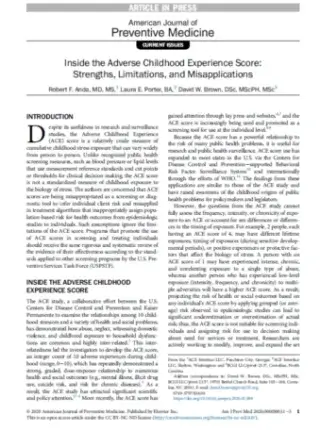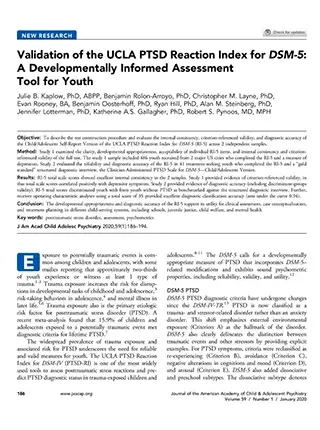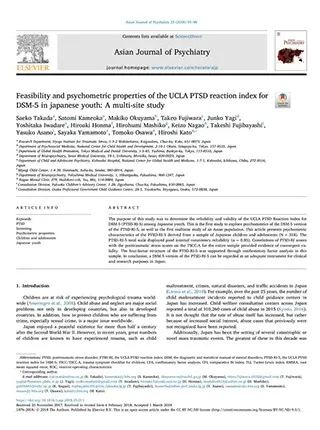Research Papers
Study Demonstrates the Utility of the UCLA Brief Screen for Trauma and PTSD.
This study, The UCLA PTSD Reaction Index for DSM-5 Brief Form: A Screening Tool for Trauma-Exposed Youth, published in the Journal of the American Academy of Child and Adolescent Psychiatry, showed that the UCLA Brief Screen exhibited excellent psychometrics, with high sensitivity and specificity for identifying children and adolescents with different levels of risk for PTSD. Those who screen positive merit consideration for further in-depth assessment and treatment. This study fills a significant gap in the literature given the need for established DSM-5 trauma and PTSD screening tools for youth.
Although psychometrically sound measures are now available to assess traumatized youth, valid brief tools are needed for screening purposes. The UCLA Brief Screen showed high levels of internal consistency, discriminant-groups validity, diagnostic efficacy, and clinical utility. ROC analyses indicated that a Brief Screen score of 21 maximized sensitivity and specificity. The Brief Screen has notable strengths that extend beyond those of other DSM-5 screening tools, including high construct coverage, a distress scale, robust psychometric properties, and clear utility for clinical and research purposes.
Researchers: Benjamin Rolon-Arroyo, PhD; Benjamin Oosterhoff, PhD; Christopher M. Layne, PhD; Alan M. Steinberg, PhD; Robert S. Pynoos, MD, MPH; Julie B. Kaplow, PhD, ABPP
Effectiveness of a Telehealth Service Delivery Model for Treating Childhood Posttraumatic Stress: A Community-Based, Open Pilot Trial of Trauma-Focused Cognitive – Behavioral Therapy
This pilot study examined the feasibility and potential effectiveness of trauma-focused cognitive–behavioral therapy (TF-CBT) delivered via telehealth to 70 trauma exposed youth in 7 underserved communities. The study used both the DSM IV (Steinberg et al., 2013) and DSM-5 (Kaplow et al., 2020) versions of the UCLA Posttraumatic Stress Disorder Reaction Index to assess trauma exposure and posttraumatic stress symptoms in youth between the ages of 7 and 18. Close to nine out of every 10 youth (88.6%) completed a full course of telehealth delivered TF-CBT, and 96.8% of these treatment completers no longer met diagnostic criteria for a trauma-related disorder at posttreatment. The study also demonstrated that both versions of the UCLA PTSD Reaction Index exhibited excellent psychometric properties and were well-suited for implementation in a virtual environment. The COVID-19 global pandemic has resulted in an unprecedented need to rethink how mental health services are delivered. The positive treatment outcome of telehealth delivered TF-CBT observed in this study are promising. This pilot begins to address a significant gap in the literature given the need for telehealth and for evidence-based outcomes to support this process.
Steward, RW, Young, J, Wallace, MM, Cohen, JA, Mannarino, AP, De Arellano, MA. (2020).
Inside the Adverse Childhood Experience Score: Strengths, Limitations, and Misapplications
This paper describes the development and use of the Adverse Childhood Experiences (ACE) questionnaire for large-scale epidemiological research. The authors point out the misapplication of using scores on the ACE questionnaire for individual screening and clinical decision making about treatment or services. They note that, despite the fact that ACE scores are associated with population-based risk for negative health, mental health, and social outcomes, it “remains unclear how ACE scores make sense for decision making as part of a community screening program.” The authors go on to note that, although there are current efforts by lawmakers to develop policies to use the ACE questionnaire for screening children and adolescents in various settings, (including mental health, pediatrics, child welfare, schools, juvenile justice, and residential care), there is no body of evidence that would support its use for that purpose, emphasizing that the ACE questionnaire was developed for research, not screening, and that it is “neither a diagnostic tool nor is it predictive at the individual level.” In sum, in authors caution against misapplication of ACE scores to determine individual risk or make decisions about clinical care.
Anda, RF, Porter, LE, Brown, DW: (2020) American Journal of Preventive Medicine.
Study Demonstrates the Validity and Clinical Utility of the UCLA PTSD Reaction Index for DSM-5.
This study, Validation of the UCLA PTSD Reaction Index for DSM-5: A Developmentally-Informed Assessment Tool for Youth, was published in the Journal of the American Academy of Child and Adolescent Psychiatry. The study of 486 youth across two independent samples showed the developmental appropriateness, diagnostic accuracy and internal consistency of the UCLA PTSD Reaction Index. The manuscript and reports on its benefit in clinical assessment, case conceptualization, treatment planning, and monitoring treatment outcomes. The Reaction Index is well suited for use in a variety of child-serving systems, including schools, residential care, juvenile justice, child welfare, and health and mental health settings.
Total scores discriminated between youth with, versus without, PTSD as benchmarked against the structured diagnostic interview, the Clinician-Administered PTSD Scale for DSM-5–Child/Adolescent Version. Further, analyses indicated that a total score of 35 provided excellent diagnostic classification accuracy. Given evidence regarding the high prevalence of trauma among children and adolescents, associated rates of PTSD, a variety of service settings can benefit from adopting developmentally-informed, psychometrically-sound, and efficient tools with which to evaluate trauma history and PTSD.
Researchers: Julie B. Kaplow, Ph.D., A.B.P.P.; Benjamin Rolon-Arroyo, Ph.D.; Christopher M. Layne, Ph.D.; Evan Rooney, B.A.; Benjamin Oosterhoff, Ph.D.; Ryan Hill, Ph.D.; Alan M. Steinberg, Ph.D.; Jennifer Lotterman, Ph.D.; Katherine A. S. Gallagher, Ph.D.; Robert S. Pynoos, M.D., M.P.H.
UCLA PTSD Reaction Index for DSM-5 among 4,201 adolescents from eleven countries showed excellent psychometrics and cross-cultural utility.
“UCLA PTSD Reaction Index for DSM-5 (PTSD-RI): A Psychometric Study of Adolescents Sampled from Communities in Eleven Countries” was published in the European Journal of Psychotraumatology. It reports on the psychometric properties using 11 translations of the DSM-5 Self-Report Version of the UCLA PTSD Reaction Index among 4,201 adolescents from communities within eleven countries worldwide. The findings contribute to the establishment of the validity of the Reaction Index, and have important implications for future epidemiological, cross-cultural, and clinical research.
The UCLA PTSD Reaction Index Total Score across 11 countries, (Brazil, Bulgaria, Croatia, Indonesia, Montenegro, Nigeria, Palestine-Gaza, Philippines, Portugal, Romania, and Serbia) for showed excellent internal consistency reliability within and across countries, and high levels of discriminant validity. The study confirmed the four-factor structure of the Reaction Index, providing cross-cultural evidence that these items represent the core PTSD symptoms as proposed by the DSM-5 criteria.
Researchers: Ana Doric, Dejan Stevanovic, Dusko Stupar, Panos Vostanis, Olayinka Atilola, Paulo Moreira, Katarina Dodig-Curkovic, Tomislav Franic, Vrljicak Davidovic, Mohamad Avicenna, Multazam Noor, Laura Nussbaum, Abdelaziz Thabet, Dino Ubalde, Petar Petrov, Azra Deljkovic, Monteiro Luis Antonio, Adriana Ribas, Joana Oliveira & Rajna Knez
Study of the Japanese translation of the UCLA PTSD Reaction Index for DSM-5 provides evidence of strong psychometric properties and utility for clinical and research purposes in Japan.
This paper, “Feasibility and psychometric properties of the UCLA PTSD Reaction Index for DSM-5 in Japanese youth: A multi-site study,” was published in the Asian Journal of Psychiatry. Findings from a sample of 318 children and adolescents from different regions in Japan confirmed the strong psychometrics of the Reaction Index. The authors, who translated and back translated the Reaction Index, note that the availability of the Japanese translation will greatly aid Japanese clinicians in their clinical decision-making and treatment planning.
The Reaction Index showed strong evidence of internal consistency reliability and convergent validity. Factor analysis confirmed the four-factor structure of the Reaction Index implied by DSM-5 criteria. The results showed that the Reaction Index is a useful and reliable tool for assessing Japanese youth’s PTSD symptoms in clinical and research settings. The authors note especially that it can serve as a useful tool for clinician communication with children and their families.
Researchers: Saeko Takada, Satomi Kameoka, Makiko Okuyama, Takeo Fujiwara, Junko Yagi, Yoshitaka Iwadare, Hiroaki Honma, Hirohumi Mashiko, Keizo Nagao, Takeshi Fujibayashi, Yasuko Asano, Sayaka Yamamoto, Tomoko Osawa, Hiroshi Kato






